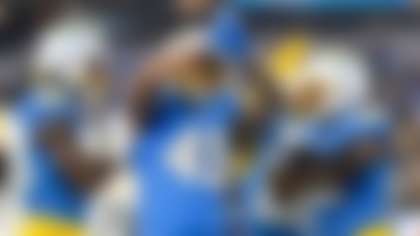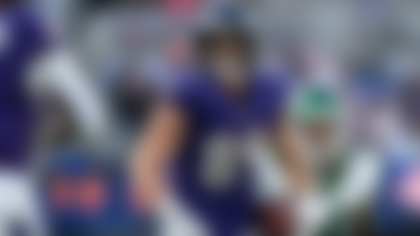The 2015 NFL season is in the books -- and now it's time to turn toward the 2016 NFL Draft. Before the NFL Scouting Combine shines the spotlight on the next crop of incoming talent, Bucky Brooks is taking a division-by-division look back at each NFL team's 2015 rookie class, providing grades and highlighting what teams should be focusing on when they head to Indianapolis.
Arizona Cardinals
Round 1 (No. 24 overall): D.J. Humphries, offensive tackle
Round 2 (No. 58 overall): Markus Golden, outside linebacker
Round 3 (No. 86 overall): David Johnson, running back
Round 4 (No. 116 overall): Rodney Gunter, defensive tackle
Round 5 (No. 158 overall): Shaquille Riddick, outside linebacker
Round 5 (No. 159 overall): J.J. Nelson, wide receiver
Round 7 (No. 256 overall): Gerald Christian, tight end
The Cardinals have emerged as a heavyweight in the NFC behind a talent-laden roster loaded with young playmakers. The "Birdgang" will remain among the NFL's elite with a rookie class that showed tremendous promise throughout the season. David Johnson is an impressive all-purpose RB1 with the size, strength and speed to deliver explosive plays as a runner or receiver. He amassed over 1,000 scrimmage yards -- and really delivered the goods as the Cardinals' feature back down the stretch of the season. J.J. Nelson flashed big-play ability as a deep threat on the perimeter. Although he only snagged 11 receptions during the regular season, seven of those grabs went for 20-plus yards, showing a glimpse of his impact potential. Markus Golden was a nice find as an energetic pass rusher off the edge. He not only has a knack for getting home (four sacks, to go along with two forced fumbles), but he plays with a relentless spirit that energizes the unit. D.J. Humphries failed to make a positive impression as a rookie, but he remains a talented prospect with immense potential. Grade: B+
Combine focus: The Cardinals' defense needs to replenish the active rushers along the front line, something they could do with the No. 29 pick in the draft.. Thus, the team likely will spend much of the combine visiting with the likes of Eastern Kentucky's Noah Spence, Georgia's Leonard Floyd, Utah State's Kyler Fackrell and Boise State's Kamalei Correa to see if they can fill roles as edge rushers. The Cardinals also could study Clemson's Kevin Dodd and Oregon's DeForest Buckner to project their potential as five-techniques in Arizona's 3-4 scheme.
Los Angeles Rams
Round 1 (No. 10 overall): Todd Gurley, running back
Round 2 (No. 57 overall): Rob Havenstein, offensive tackle
Round 3 (No. 72 overall): Jamon Brown, offensive lineman
Round 3 (No. 89 overall): Sean Mannion, quarterback
Round 4 (No. 119 overall): Andrew Donnal, offensive lineman
Round 6 (No. 201 overall): Bud Sasser, wide receiver
Round 6 (No. 215 overall): Cody Wichmann, offensive guard
Round 7 (No. 224 overall): Bryce Hager, linebacker
Round 7 (No. 227 overall): Martin Ifedi, defensive end
Beyond obvious shortcomings at quarterback, the Rams have assembled a talented collection of players on both sides of the ball during the Jeff Fisher era. The franchise continued to add quality youngsters in 2015, with blue-chipper Todd Gurley headlining a productive rookie class that made immediate contributions in Year 1. The Offensive Rookie of the Year rushed for over 1,100 yards in just 13 games (12 starts), displaying the balance, body control and explosiveness to take it the distance from anywhere on the field. Rob Havenstein, Jamon Brown and Cody Wichmann anchored an offensive line that paved the way for Gurley's dominance between the tackles. Andrew Donnal also contributed as a valuable backup/spot starter during the season. With the Rams getting key production from a number of first-year players, the future looks bright for the Rams. Grade: A-
Combine focus: The Rams, who hold the 15th overall pick, are a quarterback away from joining the title contenders in the NFC. The team desperately needs a proven playmaker at the game's most important position, which will lead Fisher and general manager Les Snead to spend countless hours studying North Dakota State's Carson Wentz, Cal's Jared Goff and Memphis' Paxton Lynch to assess their potential as franchise signal callers. Despite an annual investment in the wide receiver position, the Ramsstill need a dominant playmaker on the edge to complement Tavon Austin. Mississippi's Laquon Treadwell, Baylor's Corey Coleman, TCU's Josh Doctson and Ohio State's Michael Thomas could be in the team's crosshairs based on their potential as WR1s.
San Francisco 49ers
Round 1 (No. 17 overall): Arik Armstead, defensive lineman
Round 2 (No. 46 overall): Jaquiski Tartt, safety
Round 3 (No. 79 overall): Eli Harold, outside linebacker
Round 4 (No. 117 overall): Blake Bell, tight end
Round 4 (No. 126 overall): Mike Davis, running back
Round 4 (No. 132 overall): DeAndre Smelter, wide receiver
Round 5 (No. 165 overall): Bradley Pinion, punter
Round 6 (No. 190 overall): Ian Silberman, offensive guard
Round 7 (No. 244 overall): Trenton Brown, offensive lineman
Round 7 (No. 254 overall): Rory "Busta" Anderson, tight end
The rapid decline of the 49ers has been staggering. The team just has lost too much talent -- in addition to an exceptional head coach -- to compete in one of the toughest divisions in football. The Niners saw a ton of veteran leadership walk out the door prior to last season (see: Patrick Willis, Justin Smith and Frank Gore), and San Francisco didn't get enough help from its rookie class to make up the difference. (An impossible task, really.) Still, there are some things to be excited about going forward. Arik Armstead made tremendous strides as a rookie despite only logging one start. He could grow into a solid plugger along the interior. Jaquiski Tartt made contributions on the second level as a designated thumper between the hashes. The 49ers should be encouraged by the flashes displayed by Mike Davis and Blake Bell in spot duty -- the young offensive playmakers should contribute as rotational guys going forward. Grade: C+
Combine focus: San Francisco owns the No. 7 overall pick in the draft. With Chip Kelly coming on board, it remains to be seen what the 49ers' new coach thinks of the two QBs who started games last year (Colin Kaepernick and Blaine Gabbert). The new coaching staff could set its sights on a young QB prospect to build around. Cal's Jared Goff, North Dakota State's Carson Wentz and Memphis' Paxton Lynch could get extended looks at the combine, based on their talent and experience directing spread offenses in college. The 49ers are also in need of more speed at wide receiver, which makes Baylor's Corey Coleman, Notre Dame's Will Fuller, Ohio State's Braxton Miller and Colorado State's Rashard Higgins worthy of inspection from the team's coaches and scouts.
Seattle Seahawks
Round 2 (No. 63 overall): Frank Clark, defensive end
Round 3 (No. 69 overall): Tyler Lockett, wide receiver/returner
Round 4 (No. 130 overall): Terry Poole, offensive lineman
Round 4 (No. 134 overall): Mark Glowinski, offensive guard
Round 5 (No. 170 overall): Tye Smith, cornerback
Round 6 (No. 209 overall): Obum Gwacham, defensive end
Round 6 (No. 214 overall): Kristjan Sokoli, offensive guard
Round 7 (No. 248 overall): Ryan Murphy, defensive back
Seattle has done a great job of developing young players in the Pete Carroll era. The Seahawks have not only helped mid-to-late-round selections play at a high level, but they also have gotten exceptional performances from some of their UDFAs (undrafted free agents) in recent years. The Seahawks might've stumbled upon Beast Mode 2.0 in Thomas Rawls. The undrafted free agent tallied four 100-yard games (including one 200-yard effort) and showed team officials he was a capable workhorse runner. How well he recovers from his season-ending ankle injury could determine whether the Seahawks continue to invest in the position. Among the 2015 draftees, Tyler Lockett and Frank Clark played like seasoned vets in their respective roles. Lockett, in particular, displayed outstanding skills as a receiver/returner on the way to scoring eight total touchdowns (six receptions, one punt return and one kick return) during his rookie campaign. He looks like a natural WR2 opposite Doug Baldwin, which should encourage Carroll to carve out a bigger role for Lockett in Year 2. Clark is an energetic edge defender with a non-stop motor and explosive rush skills. He finished with three sacks and showed a knack for getting home off the edge. With more playing time, he should blossom as a DPR1 (designated pass rusher) in the Seahawks' aggressive scheme. Grade: B+
Combine focus:Lynch's retirement forces Seattle to reassess the state of the backfield. As mentioned above, the Seahawks got promising returns from Rawls in Year 1, but they'll have to see how he recovers from injury -- and honestly, they're not going to make him the unquestioned RB1 after a solid half-season of work. This draft class offers plenty of attractive options for Seattle at running back -- guys like Ohio State's Ezekiel Elliott, Alabama's Derrick Henry and Arkansas' Alex Collins fit the franchise's mold as rugged inside runners with soft hands in the passing game. Carroll will pay close attention to their combine workouts to determine if they have the ability to contribute immediately in a revamped offensive scheme that will put more responsibility on Russell Wilson's shoulders in 2016. Meanwhile, Russell Okung is a free agent, which makes offensive tackle a huge priority for the team (which holds the No. 26 pick, by the way). Mississippi's Laremy Tunsil, Michigan State's Jack Conklin, Notre Dame's Ronnie Stanley and Ohio State's Taylor Decker will all get long looks, but their workouts on the field turf could determine whether the Seahawks view them as ideal fits at left tackle.
Follow Bucky Brooks on Twitter @BuckyBrooks.












